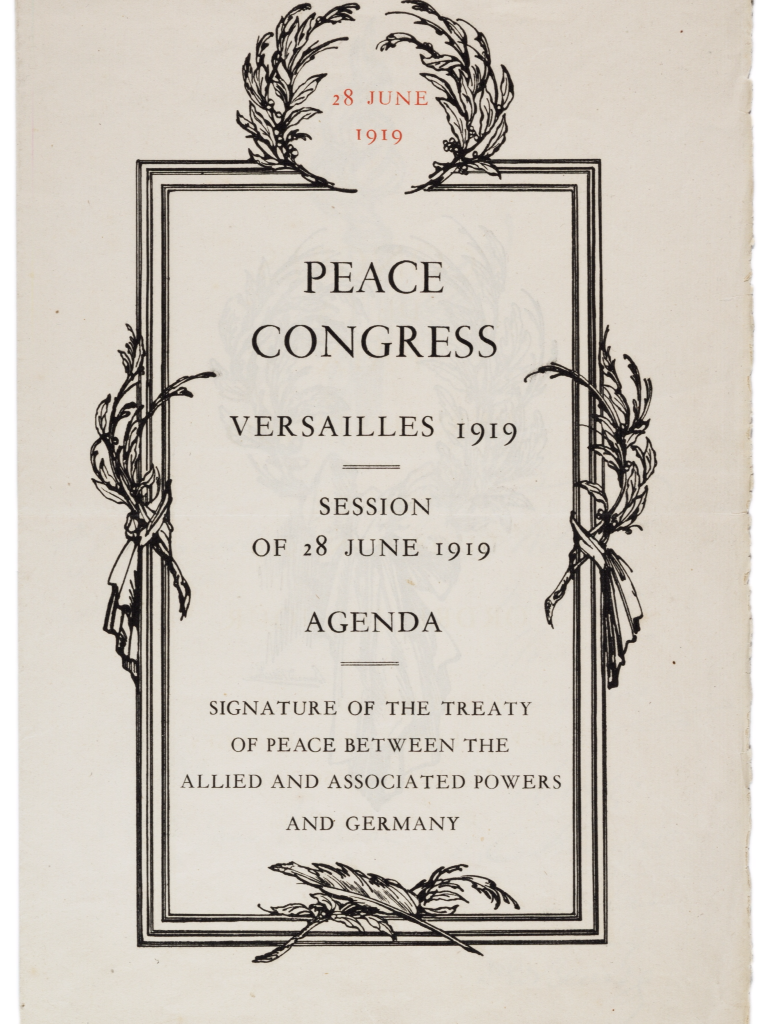Summary
In this lesson, students will analyze the impact of the Treaty of Versailles. Students will extend their learning by analyzing an article about German reparations. Student learning will be assessed by completing a Claim, Evidence, Reasoning response to a question about the treaty's impact on Germany.
Essential Question(s)
How can an agreement have unintended consequences?
Snapshot
Engage
Students respond to statements about war treaties using the Magnetic Statements strategy.
Explore
Students analyze excerpts from the Treaty of Versailles.
Explain
Students complete notes on two short videos about the Treaty of Versailles.
Extend
Students read and respond to a news article about Germany and reparations.
Evaluate
Students complete a Claim, Evidence, Reasoning response regarding the impact that the Treaty of Versailles had on Germany
Materials
Lesson Slides (attached)
Magnetic Statements posters (attached)
Analyzing the Treaty of Versailles handout (attached; 1 per student)
Cornell Notes handout (attached; 1 per student)
Claim, Evidence, Reasoning handout (attached; 1 per student)
S.I.T. handout (attached; optional; 1 per student)
Engage
20 Minute(s)
Use the attached Lesson Slides to guide the lesson. Introduce students to the Magnetic Statements strategy. Tell students all of these statements are related to how countries move forward after a major war. Show slide 3 and tell students to move around the classroom and read the posted statements. After providing time for students to read the five statements, tell students to pick one statement they are most attracted to. Tell students to talk to each other at their chosen statement and discuss why they felt drawn to that particular statement. Ask for volunteers from each statement to share the group’s thoughts about the statement. Then, show slide 4 and tell students to move to a different statement that they are repelled by and then talk at their statements about why they felt repelled by that statement. Ask for volunteers from each group to share their thoughts about the statements again. Review the essential question and lesson objective on slides 5–6.
Explore
20 Minute(s)
Pass out the attached Analyzing the Treaty of Versailles handout to students. Show slide 7 and provide students with background information on the Treaty of Versailles. Display slide 8 and have students read the selected articles from the treaty, either individually, in pairs, or as a class. After reading through the treaty excerpts, introduce students to the S-I-T (Surprising, Interesting, Troubling) strategy. As students finish reading the selected articles, guide them to create a table, using a piece of notebook paper or the attached S.I.T. handout.. Show slide 9 and tell students to think of one idea from the treaty that is surprising, one idea that is interesting, and one idea that is troubling. Tell students to use their table to organize and write their responses. Have students share their responses in small groups. Then ask for volunteers to share their responses to the class.
Explain
20 Minute(s)
Pass out the attached Cornell Notes handout or have students create the Cornell Notes template on notebook paper. Display slide 10 and read the questions that students should answer on their Cornell Notes, as well as the essential question for the top of the notes. Display slide 11 and play The Treaty of Versailles, What Did the Big Three Want? 1/2, then provide time for students to fill in their notes.
Show slide 12 and play The Treaty of Versailles, Terms of the Treaty 2/2, then provide time for students to fill in the rest of their notes.
Tell students to compare their notes with an elbow partner, then ask for volunteers to share their responses. Have a class discussion about the terms of the treaty; ask students to consider if the treaty punished Germany too harshly or was reasonable and have students share their thoughts. Ask students to think about the statements from the beginning of the lesson and ask if their initial thoughts have changed after learning about the Treaty of Versailles.
Extend
15 Minute(s)
Share the article Germany Set to Make Final World War I Reparation Payment by providing students with the link or by passing out the printed article. Display slide 13 and provide time for students to read the article in pairs or read the article as a class. Tell students to make a S-I-T table again on the notebook paper they previously used. Transition to slide 14 and have students compare their S-I-T responses in small groups. Then, ask for volunteers to share their responses.
Evaluate
15 Minute(s)
Pass out the attached Claim, Evidence, Reasoning handout and show slide 15. Introduce students to the Claim, Evidence, Reasoning strategy. Tell students to respond to the question with an answer in the first box, a piece of evidence from the lesson in the second box, and how the evidence supports the claim in the third box.
Collect completed CER responses to assess understanding of the lesson.
Resources
Crossland, D. (2010, September 29). Germany Set to Make Final World War I Reparation Payment. https://abcnews.go.com/International/germany-makes-final-reparation-payments-world-war/story?id=11755920
Image source: Sara10703. (April 28, 2016). Treaty of Versailles [Illustration]. Wikimedia Commons. https://commons.wikimedia.org/wiki/File:Treaty_of_Versailles_.png
K20 Center. (2021, August 19). Claim, Evidence, Reasoning [Video]. YouTube. https://www.youtube.com/watch?v=JGOxVIgmGWE
K20 Center. (n.d.). Claim, Evidence, Reasoning (CER). https://learn.k20center.ou.edu/strategy/156
K20 Center. (n.d.). Cornell Notes System. https://learn.k20center.ou.edu/strategy/56
K20 Center. (n.d.). Magnetic Statements. https://learn.k20center.ou.edu/strategy/166
K20 Center. (n.d.). S-I-T (Surprising, Interesting, Troubling). https://learn.k20center.ou.edu/strategy/926
Simple History. (2016, November 3). The Treaty of Versailles, What Did the Big Three Want? 1/2 [Video]. YouTube. https://www.youtube.com/watch?v=vrYhLNQMRro
Simple History. (2016, November 5). The Treaty of Versailles, Terms of the Treaty 2/2 [Video]. YouTube. https://www.youtube.com/watch?v=0jycVFL8CNM


